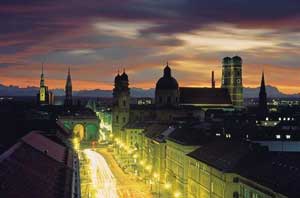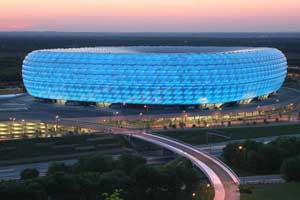
Germany 2006 FIFA World Cup VenuesFIFA World Cup Host Cities - MUNICHMunich city profile
During the reign of King Ludwig I such famous buildings as the Glyptothek, Old and New Pinakothek, the royal palace, Feldherrnhalle and Siegestor were built. Munich developed into one of Europe's most important cultural centres. Kurt Eisner proclaimed the Free State of Bavaria in 1918 and was elected Prime Minister of Bavaria. In 1933 the National Socialists, the Nazis, seized power in the City Hall. Allied air bombardments caused widespread destruction in Munich in 1944. Today the Bavarian capital on the river Isar is an economic and media metropolis with an international reputation. Munich enjoys a special place of honour in the world of sports as venue of the 1972 Olympic Summer Games. Since then innumerable events of national and international importance have been staged in the Olympiastadion in the middle of a beautiful park. These included the 1974 World Cup final, the final of EURO '88 and the UEFA Champions League Final in 1997. Munich has been one of Europe's most important sports cities since the 1972 Olympic Games. The first traditional sports clubs were founded in the last century, among them the "Turn- und Sportverein München von 1860" - TSV 1860, which together with FC Bayern München dominates Munich football. FC Bayern is the most successful German club with 18 national titles, nine Cup wins and additional titles in all European competitions. Munich offers 373 sports facilities to its 732 clubs with a total of 292,829 active members. Major Events at the Munich OlympiastadionSporting highlights like Champions League matches, Final Four in basketball, Six Day cycle races in recent times, and international track and field meetings (2002 European Championships) are regularly staged in the Bavarian capital Munich and the Olympic Park. Munich stadium profilePopulation: 1.3 millionStadium: FIFA World Cup Stadium Munich Project: New stadium Investment: approx 280 million Euro Gross Capacity: 66,016 Total Seating Capacity: 59,416 (*) Purchasable Ticket Capacity (**)
The 66,000 capacity stadium was inaugurated on 30 and 31 May 2005 by joint owners TSV 1860 Munich and FC Bayern Munich, Germany's most successful club. The first Bundesliga goal at the new ground was scored by England international Owen Hargreaves in Bayern's 3-0 victory over Borussia Monchengladbach. In a municipal referendum held in October 2002, 65.8 percent voted in favour of constructing a purpose-built football stadium. Some 37.5 percent of the citizens registered to vote actually did so, the highest-ever turnout in a Bavarian referendum. The radical concept proposed by Swiss architects Herzog and de Meuron was adopted in February 2002. OC President Franz Beckenbauer led the ceremony to lay the foundation stone in October 2002. The seven-storey structure was completed in April 2005. Some 120,000 cubic metres of concrete and 20,000 tonnes of steel were needed. The ground is situated to the north of the Bavarian capital in the district of Fröttmaning, with ideal traffic connections via the A9 motorway. The extraordinary facade consists of 2,874 EFTE (ethylene tetrafloroethylene) foil panels. The self-cleaning, fire, heat and cold-resistant panels are inflated to a permanent pressure of 350 Pascal. Each panel can be separately illuminated in white, blue or red, creating a breathtaking backdrop at night games. Regulations do not allow the lighting effect to be changed more than every two minutes in order to minimise distraction to motorway traffic. The three-tier arrangement in the stands is unique in the Bundesliga. The highest tier still provides superb views thanks to a steep 34 degree rake. Europe's largest underground car park on the site provides almost 10,000 parking spaces. In March 2004, FIFA named Munich as the venue for the Official Opening Ceremony of the 2006 FIFA World Cup. The ceremony takes place ahead of the Opening Match on 9 June 2006. The 2006 FIFA Congress will also be convened in Munich. The Bavarian metropolis is the location for the International Media Centre. The new stadium stages the Opening Match, a semi-final and four more matches at the tournament. Financing: (*) "Total Seating Capacity" means the Gross Capacity less the seats unavailable for use due to restricted views and security/contingency reserves for the 2006 FIFA World Cup. This capacity is estimated and may change once these deductions are finally determined.
|
|||||||||||||||||||||||
Recommended Sportsbook
Bookmaker Sportsbook is a recognized sports betting leader since 1985. BookMaker provides safe, legal, and secure betting on major sporting events, as well as horse racing, casino, and poker entertainment, from any location in the world, 24 hours a day 7 days a week. Bookmaker is the number one legal online sports betting and entertainment center of America. Bonded and fully licensed by the Government of Costa Rica. With a reputation like this everyone should have an account.
Bookmaker covers all needs for any real gambler. If you do not have an account with Bookmaker you are making a very big mistake. Signing up now is better than ever as gives you the best bonuses available. With an array of bonuses and the best reputation, Bookmaker is a must have for A list sportsbook betting fans. Sign up today!
 Henry the Lion founded Munich in 1158. Munich was ranted town rights in 1214 and became the seat of power of the duchy of Bavaria-Munich in 1255. Gustav Adolf of Sweden occupied the city during the Thirty Years War; in 1806 Munich became the capital of the kingdom of Bavaria.
Henry the Lion founded Munich in 1158. Munich was ranted town rights in 1214 and became the seat of power of the duchy of Bavaria-Munich in 1255. Gustav Adolf of Sweden occupied the city during the Thirty Years War; in 1806 Munich became the capital of the kingdom of Bavaria.  The arena chosen to host the German national team in the Opening Match of the 2006 FIFA World Cup on 9 June 2006 boasts a truly unique exterior, guaranteeing the stadium a place among the most unusual and spectacular venues in the world. The smooth facade formed from translucent, lozenge-shaped cushions glows in a variety of colours to imbue the structure with a shimmering, magical poetry.
The arena chosen to host the German national team in the Opening Match of the 2006 FIFA World Cup on 9 June 2006 boasts a truly unique exterior, guaranteeing the stadium a place among the most unusual and spectacular venues in the world. The smooth facade formed from translucent, lozenge-shaped cushions glows in a variety of colours to imbue the structure with a shimmering, magical poetry.